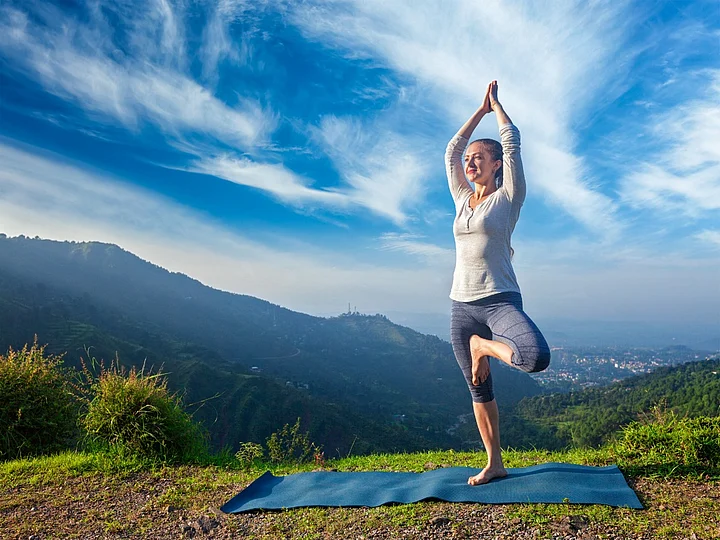A stroke occurs when a blood vessel in the brain ruptures. It may also be due to the blockage in the blood supply to the brain. A stroke hinders speech and memory and affects the movement of the arms or legs on one side of the body. Strokes can also cause difficulty with balance resulting in involuntary falls.
Yoga is known for the prevention of chronic diseases, including strokes. Yoga asanas can also help manage stress, blood pressure, and cholesterol, besides helping maintain a healthy weight. These things together help lower the risk of a stroke. Yoga also improves cognition and mood, which are essential factors that help with stroke prevention.
Cobra Pose
This stretches your abdomen, chest, and shoulders. It strengthens your spine and may soothe sciatica. It helps the muscle groups: hamstrings, gluteus maximus, deltoids, triceps, and serratus anterior. It also helps manage stress.
Follow the steps:
Lie on your stomach and place your hands under your shoulders with your fingers facing forward.
Draw your arms to your chest, and your elbows should not go out to the side.
Press into your hands and slowly lift your head, chest, and shoulders.
Lift part way, halfway, or all the way up.
Slightly bend your elbows.
Let your head drop back to deepen the pose.
Release back down to your mat and breathe out.
Bring your arms by your side and rest your head.
Slowly move your hips from side to side to release tension.
Bow Pose
This is an easy and quite effective pose that strengthens the abdominal muscles. According to the Yoga Institute, it is an effective pose to maintain healthy skin and adds a glow as well. It puts pressure on the abdominal portion and helps in detoxifying. It is an advanced pose; so do not push your body too hard.
Lie flat on the stomach, use a soft surface or a yoga mat.
Bend your knees slowly.
Slowly extend your arms backward and try to clasp the ankles.
Now, gently raise your chest off the floor as far as you can go.
While using the tension between the arms and legs, lift the thighs and upper body off the floor.
Hold the pose for a few seconds, then release.
Warrior Pose
The warrior pose is another traditional pose practised by people with various medical conditions, one of which is weak pelvic muscles. This yoga pose helps in strengthening the arms, legs, and lower back as well. You can:
Stand up with your legs 4 to 5 feet apart.
Place your right foot at a 90-degree angle and your right toe should point out at an angle of 45 degrees.
Place your hands at shoulder level, parallel to the ground.
Bend your right knee and look towards your right.
Your hips should be square and the right thigh should be parallel to the ground.
Hold the pose for 10 to 15 seconds and release the posture.
Boat Pose
The position of your neck during Boat Pose has a positive effect on the thyroid glands in the human body. It helps:
Tone the muscles of the abdomen
Strengthen the lower back
Opens the chest and engages the core muscles
Strengthens the hip flexors and adductor muscles
Stretches the hamstrings
Alleviate tightness in the hamstrings
To practice this pose, you will have to sit on the floor and extend your legs in front of you. Place your hands on the floor beside you, and let your upper body lean back slightly. Make sure your spine is straight and your chin is tucked in toward your chest.
Slowly try to balance on your two sitting bones and tailbone. Bend your knees before you lift your legs in the air and straighten your legs.
Mountain Pose
Mountain Pose is known to enhance the body awareness, correct imbalance, and improve alignment, which reduces your risk of injury. Follow these steps:
Stand in such a way that your big toes touch each other.
Lift and fan out your toes and drop them back to create a solid wide base.
Root down your feet and calves down into the floor.
Ensure that your quadriceps are engaged, then draw them upward. Your kneecaps will rise.
Rotate both thighs inward.
Try to maintain the natural curves of your spine.
Draw the belly slightly in, tone your belly.
Widen your collarbones and make sure your shoulders are aligned with your pelvis.
Shrug your shoulders up to your ears and roll them back to release your shoulder blades down your back.
Hang your arms naturally with the elbows slightly bent.
Hold the pose for 5 to 10 breaths while you hold yourself in this position.
(At The Quint, we question everything. Play an active role in shaping our journalism by becoming a member today.)
